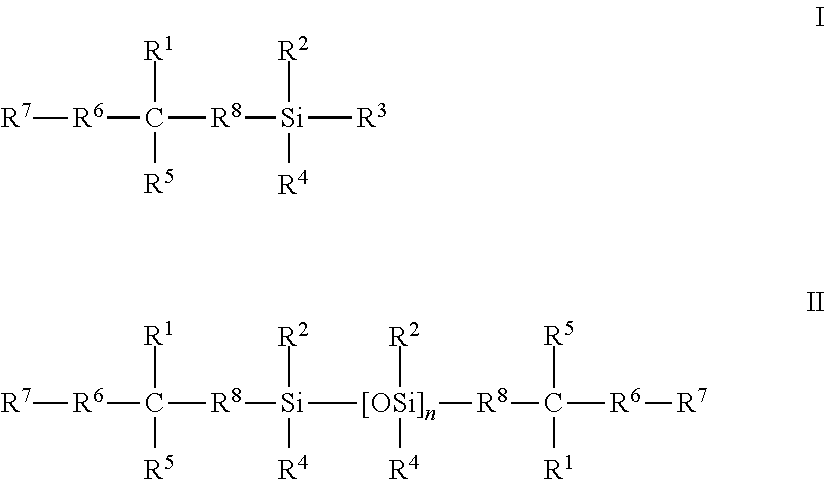Silicone hydrogels formed from reaction mixtures free of hydrophilic monomers
- Summary
- Abstract
- Description
- Claims
- Application Information
AI Technical Summary
Benefits of technology
Problems solved by technology
Method used
Image
Examples
examples 1-4
[0141]The clear blends in Table 1 were formed by combining all components and mixing overnight at room temperature. (The amount of all lens components is provided in weight %. The % diluent is provided as a weight % of the combination of lens components and diluent.) The blends were deoxygenated by placing under vacuum, then backfilling with N2 gas. Lenses were made using molds made from Zeonor (front half) and polypropylene (back). Before forming lenses the molds were stored in a nitrogen environment overnight. In a N2 filled box, 75 μl of the blend is transferred into each of the front mold halves, and quartz plates were placed on the closed molds. The mold were closed and irradiated at 55-60° C. for 15 minutes using Philips TL 20W / 03T fluorescent bulbs to provide about 1-1.5 mW / cm2 light at the mold. The molds were opened and the lenses were released into a 70 / 30 (vol) solution of IPA and water. The solution was replaced three times to extract the lenses. The lenses were then pla...
examples 5 and 6
[0142]Lenses were made using the formulations in Table 2, and the procedure from EXAMPLE 1. The resulting lenses were sticky, semi-solid lenses which were not further processed. Examples 5 and 6 show that increasing the diluent to 30 wt % or more creates sticky, semi-solid lenses which are difficult to process.
TABLE 2MaterialExample 5Example 6SiGMA57.457.4mPDMS 10001515acPDMS 200055TEGDMA00Norbloc2.22.2PVP K902020PVP K3000CGI 8190.330.33% Diluent3040Diluent3:2 t-amyl alcohol and3:2 t-amyl alcoholD3Oand D3O
examples 7 and 8
[0143]Lenses were made from the formulations in Table 3, using the procedure of Example 1. The properties of the resulting lenses are shown in Table 4.
TABLE 3MaterialExample 7Example 8OH-mPDMS, n = 46565mPDMS 100011.511.5acPDMS 100050acPDMS 200005TEGDMA1.751.75Norbloc2.22.2PVP K9014.814.8CGI 8190.280.28% Diluent2424Diluent3:2 t-amyl alcohol and3:2 t-amyl alcoholcapric acidand capric acid
TABLE 4Example 7Example 8% Water content1819Tensile strength (psi)112156Modulus (psi)336254% Elongation at break69154Toughness (in.# / in2)41136Haze19%6%Dk, barrersNM245NM means not measured
[0144]Examples 7 and 8 show that silicone hydrogels having a desirable balance of properties may be made from reaction mixtures which do not comprise any reactive hydrophilic components.
PUM
| Property | Measurement | Unit |
|---|---|---|
| Percent by mass | aaaaa | aaaaa |
| Percent by mass | aaaaa | aaaaa |
| Percent by mass | aaaaa | aaaaa |
Abstract
Description
Claims
Application Information
 Login to View More
Login to View More - R&D
- Intellectual Property
- Life Sciences
- Materials
- Tech Scout
- Unparalleled Data Quality
- Higher Quality Content
- 60% Fewer Hallucinations
Browse by: Latest US Patents, China's latest patents, Technical Efficacy Thesaurus, Application Domain, Technology Topic, Popular Technical Reports.
© 2025 PatSnap. All rights reserved.Legal|Privacy policy|Modern Slavery Act Transparency Statement|Sitemap|About US| Contact US: help@patsnap.com



